Reserve Bank of Australia Annual Report – 2017 Accountability and Communication
The Reserve Bank is an independent central bank, accountable to the Parliament of Australia. The Bank engages with the Australian Government at a range of levels and seeks to enhance the community's understanding of its responsibilities, policies and actions through a broad communication program.
Relationship with Government
The Reserve Bank is a body corporate distinct from the Commonwealth of Australia. This body corporate, established under the Commonwealth Bank Act 1911 and continued in existence under the Commonwealth Bank Act 1945, was preserved and continued in existence with the name Reserve Bank of Australia under the Reserve Bank Act 1959. The Reserve Bank has two boards: the Reserve Bank Board and the Payments System Board. The Governor, Deputy Governor and other members of the Reserve Bank Board are appointed by the Treasurer. Six of the eight members of the Payments System Board, including the Governor, are appointed by the Treasurer, with one member each appointed by the Reserve Bank and the Australian Prudential Regulation Authority.
The Reserve Bank's two boards are afforded operational independence under the Reserve Bank Act to determine and implement the policies of the Bank, as will best contribute to the objectives set out in the Act. In terms of monetary policy, The Statement on the Conduct of Monetary Policy, as updated from time to time, has recorded the common understanding of the Governor, as Chair of the Reserve Bank Board, and the government on key aspects of Australia's monetary and central banking policy framework since 1996, as outlined in the chapter on ‘Our Role’. The Payments System Board issues its own annual report, which outlines its role and activities.
Accountability and Communication
The Reserve Bank seeks to ensure a high degree of transparency about its activities, goals, decision-making processes and the basis of its policy decisions. Transparency facilitates the Bank's accountability, to accompany its operational independence. Importantly, it also increases the effectiveness of policy decisions by promoting a better understanding of those decisions in the community. There are a number of steps the Bank takes to achieve this transparency, as discussed below. These steps are an important element of the arrangements agreed between the Governor and the Treasurer as set out in the Statement on the Conduct of Monetary Policy.
The Reserve Bank Board has an obligation to inform the government of its monetary and banking policy ‘from time to time’. This obligation is discharged mainly by regular contact between the Governor and other senior executives and the Treasurer, who is the Bank's responsible Minister (during 2016/17, The Hon Scott Morrison MP), usually by way of a monthly discussion following Board meetings. The Reserve Bank Act sets out a clear process for managing differences of opinion between the Reserve Bank Board and the government on policy matters.
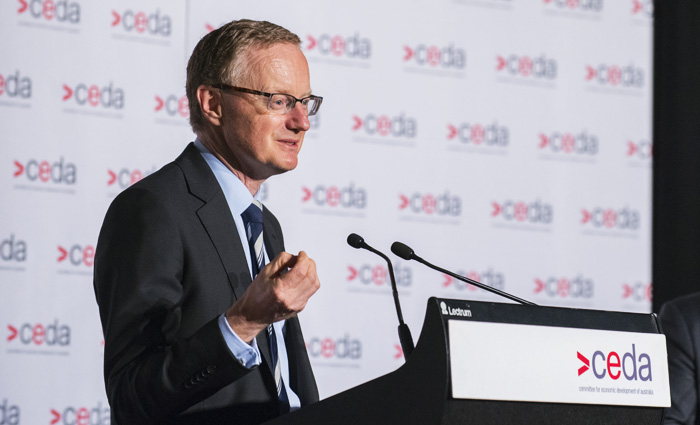
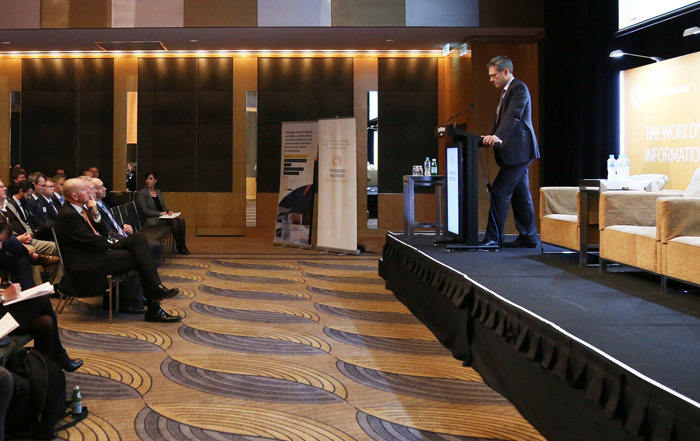
(Top) Governor Philip Lowe addresses the CEDA Annual Dinner, November 2016; (above) Deputy Governor Guy Debelle speaking about the FX Global Code of Conduct at a Thomson Reuters industry event, June 2017

The Reserve Bank is a corporate Commonwealth entity under the Public Governance, Performance and Accountability Act 2013 (PGPA Act), of which the Governor is the ‘accountable authority’. Under section 46 of the PGPA Act, the Governor is responsible for the preparation of this annual report and for providing it to the Treasurer for presentation to the Parliament, following approval by the Reserve Bank Board of the Bank's annual financial statements. That approval was given by the Board at its meeting on 1 August 2017.
The House of Representatives Economics Committee has, in its Standing Orders, an obligation to review the annual report of the Reserve Bank and the annual report of the Payments System Board. The committee holds twice-yearly public hearings, at which the Bank presents its views on the economy and financial markets and other matters pertaining to the Bank's operations, and responds to questions from committee members. In 2016/17, the Governor and senior Bank officers attended hearings of this committee for this purpose in Sydney in September 2016 and February 2017. The committee issued its report on the September 2016 hearing – Review of the Reserve Bank of Australia Annual Report 2015 (Second Report) – on 7 November 2016. The committee's report on the February 2017 hearing – Review of the Reserve Bank of Australia Annual Report 2016 (First Report) – was issued on 30 March 2017.

Novatti Chief Executive Officer Peter Cook, Reserve Bank Head of Payments Policy Department Tony Richards, Australian Payments Network Chief Executive Officer Leila Fourie, eftpos Chief Product Officer Marie Kellett and RFi Group Head of Payments – Lead Consultant Alex Boorman during the panel discussion at the Australian Retail Banking Summit, May 2017
No report on the Reserve Bank was issued in 2016/17 by the Commonwealth Ombudsman, the Office of the Australian Information Commissioner or the Auditor-General, apart from that dealing with the annual audit of the Bank's annual financial statements.
The Bank communicates and engages regularly with the public in a range of other ways, as discussed below.
Regional and industry liaison
In addition to its Head Office located in Sydney, the Reserve Bank has offices in Adelaide, Brisbane, Melbourne and Perth, whose key purpose is to conduct the Bank's regional and industry liaison program. These offices also play an important role in the Bank's communication with members of the public, business, community organisations, government and academia in their respective states.
Reserve Bank staff meet regularly with businesses, associations and agencies in every state and across all industries in the Australian economy. In 2016/17, staff involved in the regional and industry liaison program conducted over 900 such meetings. The discussions with individual firms occur around every six to twelve months, although staff tend to speak more frequently with firms in industries that are bellwether indicators of economic activity and consumer price pressures.
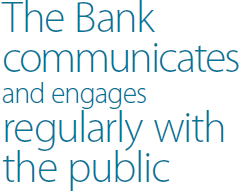
The information collected under the liaison program complements that available from official sources and helps the Reserve Bank to monitor cyclical and structural developments, as well as the effect of unusual events on the Australian economy. The broad messages gathered through liaison are incorporated into the Bank's policy discussions and public communication. While much of this information is used internally in helping shape the Bank's assessment of the Australian economy, a number of the topical articles that feature regularly in the Reserve Bank Bulletin draw on the broad themes and messages coming from the liaison program.
Staff from the State Offices also play a role in the Reserve Bank's efforts to keep the public informed of its evolving views on the economy and the functions of the Bank more generally.
They hold discussions with a broad cross-section of the community, regularly giving presentations on economic developments to business groups, community organisations and educational institutions in state capitals and regional centres. In 2016/17, staff from the Bank's State Offices gave nearly 50 of these presentations. These involved a mix of smaller, round-table sessions, as well as presentations to high school and university economics students as part of the Bank's public education program (see the chapter on ‘Community Engagement’).
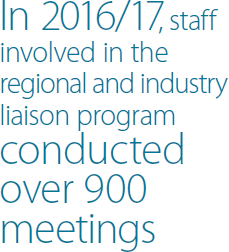
Staff from the State Offices also regularly visit Tasmania and the Northern Territory to gather information on economic conditions in those parts of Australia. In 2016/17, staff also visited regional centres, including Bunbury and Kalgoorlie in Western Australia, Ballarat and Geelong in Victoria, the Barossa Valley in South Australia and the Gold Coast in Queensland.
The Reserve Bank also continues to convene its Small Business Finance Advisory Panel, which was established in 1993. The panel meets annually to discuss issues relating to the provision of finance and the broader economic environment for small businesses. Membership of the panel is drawn from a range of industries across the country. The panel provides a valuable source of information on financial and economic conditions faced by small businesses. The Bank's liaison program also involves Bank staff meeting with a number of small businesses and small business groups.
Consultation and other engagement
Feedback from public consultation is an important input to decision-making by the Reserve Bank. In 2016/17, the Bank conducted a formal consultation on issues relating to dual-network cards and mobile wallet technology. On the basis of this consultation and resulting outcomes, the Payments System Board decided that there was no need for regulation in this area. The Bank continues to monitor developments in mobile payments, as discussed further in the Payments System Board Annual Report 2017.
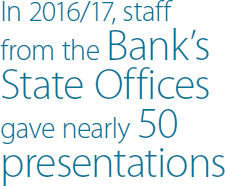
A consultation was also conducted in early 2017 by the Council of Financial Regulators (CFR) – comprised of the Reserve Bank, the Australian Prudential Regulation Authority, the Australian Securities and Investments Commission and the Australian Treasury – in relation to policy guidance that would be required to ensure safe and effective competition in cash equity settlement in Australia. The council agencies subsequently considered the responses received, with a view to advising the government in the second half of 2017 on the need for additional policy guidance.
The Reserve Bank also maintains ongoing engagement with a wide variety of groups to inform its policy and operational activities. Senior Bank staff meet regularly with representatives of various domestic and international official agencies, business groups and financial market participants to discuss economic and financial developments.
During the year in review, senior staff members from the Payments Policy Department participated in a number of industry conferences where the Bank's work in this area was discussed.
Staff from Payments Settlements Department continued to conduct regular liaison meetings with Reserve Bank Information and Transfer System (RITS) members and to participate in various industry forums, including the Australian Payments Network's High Value Clearing System Management Committee. In 2016/17, Bank staff also actively participated in the industry's New Payments Platform (NPP) project committees and were represented on the NPP Australia Limited Board. Participation in these groups and a number of other banking and payments industry forums ensures Bank staff are abreast of developments in these areas and can contribute to innovations in the banking and payments industry. Bank staff are closely following developments in new technologies, including distributed ledger technology (DLT), digital currencies and payments-related financial technology (or fintech) more broadly.
The Bank sponsors, and its International Department provides the secretariat to, the Australian Foreign Exchange Committee. Among other things, in 2016/17 the Committee coordinated the input of local market participants into the development of the global code of conduct for the wholesale foreign exchange market. During the year in review, staff from the Note Issue Department also continued to engage extensively in relation to the new banknote series, as discussed in the chapter on ‘Banknotes’.
Research
The Reserve Bank disseminates the results of longer-term research conducted by staff in the form of Research Discussion Papers (RDPs). The purpose of the RDP series is to encourage discussion and comment on policy-relevant issues. The views expressed in RDPs are those of the authors and do not necessarily represent those of the Bank. During 2016/17, 10 RDPs were published on a range of topics, including: the household cash flow channel of monetary policy; measuring the uncertainty of the economic outlook; the cyclicality of the labour market; the interbank overnight cash market; productivity; and consumption. Reserve Bank staff also published their research in various external publications, including the American Economic Journal: Economic Policy and The Economic Record.

Research undertaken at the Reserve Bank is frequently presented at external conferences and seminars. In 2016/17, Bank staff presented at a number of conferences and institutions in Australia and overseas, including in Hong Kong, several European countries and China.
The Reserve Bank hosts regular conferences, which foster interaction between academics, central bankers and other economic practitioners on topical policy issues. The Bank's annual conference for 2017 was held in March and focused on monetary policy and financial stability in a world of low interest rates. A volume containing the conference papers and discussions will be published in the second half of 2017. The next annual conference is scheduled for the first half of 2018.
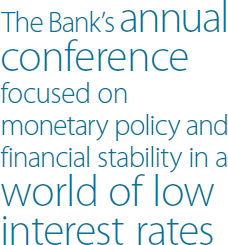
The Reserve Bank also hosted visitors from a number of overseas organisations in 2016/17. Visitors from the United States included representatives from the Federal Reserve Bank of Cleveland, the Federal Reserve Bank of New York and the Federal Reserve Bank of St Louis. The Bank also welcomed visitors from the Bank of Japan, the Bank of Papua New Guinea, the Indonesian Ministry of Finance and the Bank of Lebanon. Meetings hosted by the Reserve Bank were attended by staff from a range of international bodies, including the International Monetary Fund and the Trans-Tasman Council on Banking Supervision. The Bank welcomed academics from overseas institutions, including Columbia University, Loughborough University, the Massachusetts Institute of Technology, Northwestern University, the University of Michigan and Université Toulouse 1 Capitole.
These visitors presented seminars, taught short courses and participated in research activities at the Bank.
Public Communication
The Reserve Bank informs the public about policy decisions, analysis and the Bank's operations through its website, publications, speeches and media releases throughout the year.
Announcements about monetary policy decisions are made shortly after each Reserve Bank Board meeting and minutes are released two weeks after each meeting. A media release is published following Payments System Board meetings outlining issues discussed at the meeting and foreshadowing any forthcoming documents to be released by the Bank.
The quarterly Statement on Monetary Policy provides information about the Reserve Bank's assessment of current economic conditions, both domestic and international, along with the outlook for Australian inflation and output growth. The Statement contains a detailed analysis of conditions in the economy and financial markets and describes the outlook for inflation and the economy more generally.
The Financial Stability Review, published semiannually, provides a detailed assessment of the condition of Australia's financial system, along with analysis of financial system issues of special interest. In the year in review, focus areas included risks associated with residential mortgage lending, the impact of the mining sector adjustment on the commercial property and business sectors, and developments in overseas markets and emerging risks. The Review also reports on international regulatory developments and the Reserve Bank's involvement, and on domestic regulatory issues, including through the Bank's work with the CFR, which the Governor chairs.

Assistant Governor (Economic) Luci Ellis addresses the launch of the Women in Economics Network, March 2017
The Reserve Bank's quarterly Bulletin contains analysis of a broad range of economic and financial issues as well as aspects of the Bank's operations. During the year in review, the Bulletin contained articles on the labour market, developments in financial markets and regional variations in economic performance across Australia. Australia's housing market and the importance of inflation expectations for price stability were examined. There were also articles on various aspects of Chinese financial markets and the increasing sensitivity of Australian financial markets to news about the Chinese economy. Other articles reported on the results of the Reserve Bank's 2016 Consumer Payments Survey and the future of card, cash and cheque payments. Other topics explored in the Bulletin included trends in banknote counterfeiting, bank fees, bank funding costs, capital flows and the macroprudential policy framework.
During 2016/17, the Governor, Deputy Governor and other senior officers gave 47 public speeches on various topics. Questions were taken after almost all speeches. Senior staff also participated in a number of public panel discussions. In addition to communicating the Reserve Bank's analysis of domestic and global economic conditions, speeches covered the operation of Australia's flexible medium-term inflation target in a low-inflation environment, the FX Global Code, the Bank's new regulatory framework for surcharging of card payments and the changing nature of Australia's workforce. Senior officers also addressed the evolution of the Bank's work on financial stability, recent trends in Australian capital flows and the participation of women in the economy and the economics profession. The Bank provided ongoing support to the Women in Economics Network, with Assistant Governor (Economic) Luci Ellis speaking at the network launch in Canberra in March 2017. Audio files of these speeches, the associated question and answer sessions and panel discussions were published on the Bank's website to facilitate transparency and accountability.
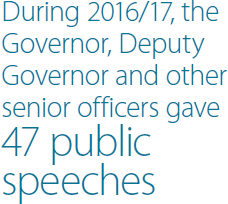
To assist further with public understanding of the Reserve Bank's role, in June 2017 the first event in the new Teacher Immersion Series was held, providing secondary school economics teachers with the opportunity to learn directly from, and about, the Bank. See the chapter on ‘Community Engagement’ for further details.
The Reserve Bank publishes information in both electronic and hard copy formats, though most access to information is now online. The Bank's website received around 125 million page views and downloads during 2016/17. Followers of the Reserve Bank's Twitter account, @RBAinfo, have grown in number to over 35,000, while the number of subscribers to the conventional email alert service has continued to fall (to less than 10,000 at the end of June 2017). Visitors to the website also made use of the RSS feeds, which allowed them to receive alerts about updates to selected data, media releases, speeches, research papers and other publications (including those related to Freedom of Information requests).
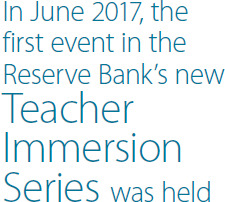
The Reserve Bank's website, which was substantially upgraded in 2015, continued to evolve during the year in review, with the addition of new videos, interactive elements and other features. The Banknotes microsite (www.banknotes.rba.gov.au) focuses on explaining the design, production and security features of Australia's banknotes. During 2016/17, it was further developed as an information and education resource in order to provide information to the public and key stakeholders about the new banknote series being issued by the Bank and support the related communication campaign. The microsite, which provides resources in a number of engaging formats, such as interactive elements, videos, photos and promotional materials, has been an effective platform to share information about the new banknotes. The microsite received a significant increase in visitor traffic in the months following the release of the new $5 banknote in September 2016.